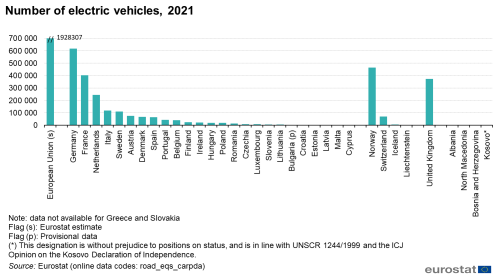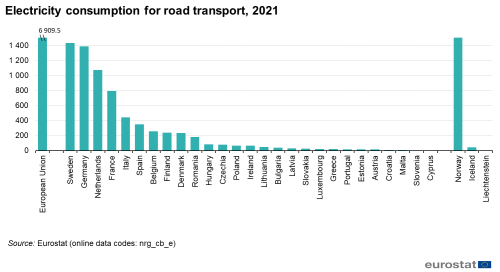Archive:Electric vehicles and energy generation statistics
Data extracted in March 2023.
Planned article update: March 2024.
Highlights
This article sheds light on electricity generation and transport data for electric vehicles. It covers the European Union (EU) and when available, it also includes data from Iceland, Liechtenstein and Norway. Transport is one area where electricity needs will be increased in the future. The first part of the article describes electric and hybrid vehicles' trends at county level. The second part analyses electricity generation data. Electricity generation per country is a strong indicator of the energy source used for the electricity consumed for charging electric vehicles. However, electricity trade can affect this picture.
An electric vehicle charging in 2021 was using electricity produced by (highest shares of each energy source):
- 11.6 % from solar photovoltaics in Malta
- 48.6 % from wind in Denmark
- 68.4 % from nuclear in France
- 71.1 % from solid fossil fuels in Poland
- 86.1 % from natural gas in Malta
- 84.9 % from oil and petroleum products in Cyprus
Full article
Transport sector data analysis
Total number of passenger electric vehicles (battery only) on the road
Figure 1 shows the total number passenger electric vehicles (battery only) on the road per country. It is higher in Norway (343 707), Germany (309 083), France (244 519) and Netherlands (173 964). Data are not available for Bulgaria, Greece and Slovakia.
Growth rate of electric vehicles number compared with previous year
Figure 2 presents the growth rate of electric vehicles. In 2020 compared to 2019, new registrations of electric vehicles have substantially increased. The largest increase was seen in Italy, Germany and Romania, with 233.5 %, 226.2 %, 207.4 % respectively. Despite the fact electric vehicles penetration is comparatively low, their growth rates is above 125% for all countries.

(%)
Source: (road_eqs_carpda)
Share of electric vehicles in the total number of passenger vehicles
Figure 3 presents the share of electric vehicles in the passenger cars fleet per country. In 2020, Norway, Netherlands and Liechtenstein had the largest share with 11.7 %, 2 %, and 1.3 % respectively. However, the absolute numbers remain relatively low for all countries.
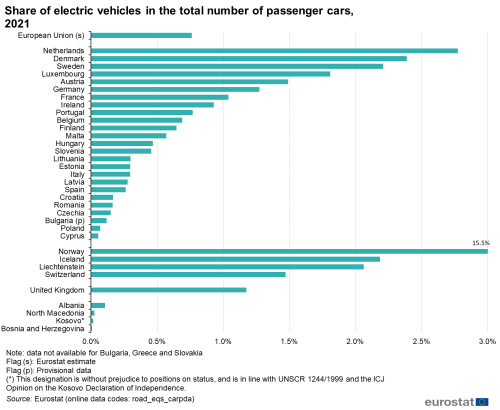
(%)
Source: (road_eqs_carpda)
Electricity sector data analysis
Gross electricity production
At EU level in 2020 (figure 4), renewables and biofuels accounted for 39.1 % of the total gross electricity production, natural gas and solid fossil fuels production corresponded to 32.8 %, whereas nuclear contributed with 24.6 % of the gross electricity production.
Figure 5 shows the percentage of gross electricity production from solid fossil fuels. Poland, Czechia and Bulgaria, with 68.0 %, 38.1 % and 33.2 % respectively, are the countries with the highest percentage of gross electricity production from fossil fuels. Gross electricity production from solid fossil fuels in Sweden, Estonia, Cyprus, Latvia, Lithuania, Luxembourg, Malta, Iceland and Norway is zero or negligible.
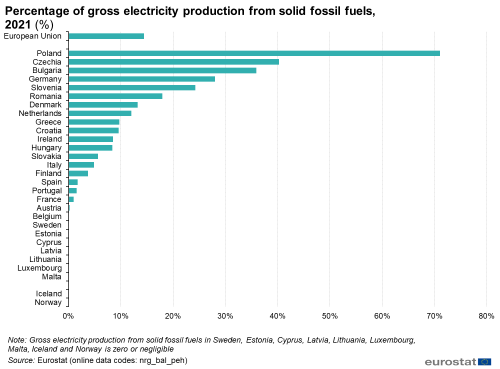
(%)
Source: Eurostat (nrg_bal_peh)
Figure 6 depicts the percentage of gross electricity production from natural gas. In the EU, the share of gross electricity production from natural gas is 20.1 %. Malta with 85.9 %, Netherlands (59.1 %) and Ireland (50.3 %) produce more than half of their gross electricity from natural gas. Gross electricity production from natural gas in Cyprus, Sweden and Iceland is zero or negligible.
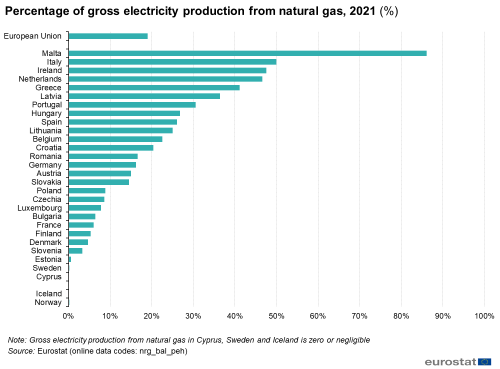
(%)
Source: Eurostat (nrg_bal_peh)
Figure 7 shows the percentage of gross electricity production from oil and petroleum products. EU countries typically produce a low or negligible percentage of gross electricity from oil and petroleum products. An obvious exception to this is Cyprus, where 87.7 % of gross electricity production comes from oil and petroleum products, as well as to some extent Greece and Spain, where this figure stands at 9.8 % and 4.1 %, respectively. However, this is slowly changing, as the rise in renewables is reducing the need for their use in electricity production.

(%)
Source: Eurostat (nrg_bal_peh)
Figure 8 presents the share of nuclear in the gross electricity production. The thirteen countries that use nuclear energy in their mix are France, Slovakia, Hungary, Belgium, Bulgaria, Sweden, Slovenia, Czechia, Finland, Spain, Romania, Germany and Netherlands. The highest percentage in 2020 was recorded in France, which produced 66.9 % of its gross electricity using nuclear, while the Netherlands, with 3.3 %, had the lowest share of nuclear electricity among the 13 producing countries.
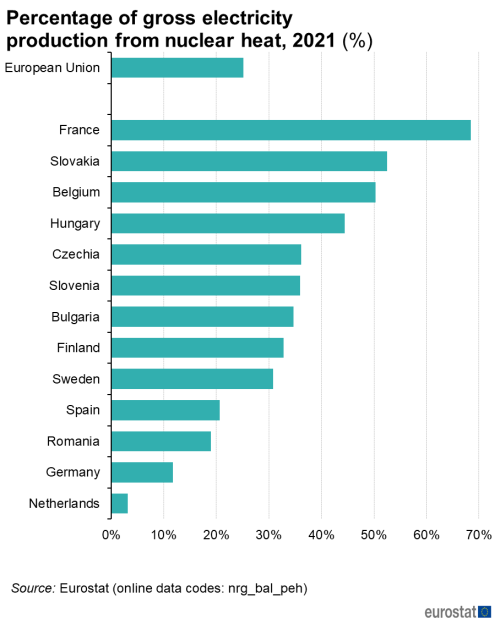
(%)
Source: Eurostat (nrg_bal_peh)
The share of electricity produced from wind in the total gross electricity was highest in Denmark, Ireland and Lithuania in 2020, who reported 56.8 %, 35.8 % and 29.2 % respectively. By contrast, gross electricity production from wind in Slovenia, Slovakia, Malta and Iceland was zero or negligible.

(EUR per kWh)
Source: Eurostat (nrg_bal_peh)
Figure 10 shows the percentage of solar in gross electricity production in 2020. Malta, Greece and Italy had the highest percentage with 11.1 %, 9.2 %, 8.9 % respectively. The lowest was observed in Finland (0.3 %), Ireland (0.2 %) and Latvia (0.1 %). Gross electricity production from solar photovoltaics in Iceland and Norway is zero or negligible.
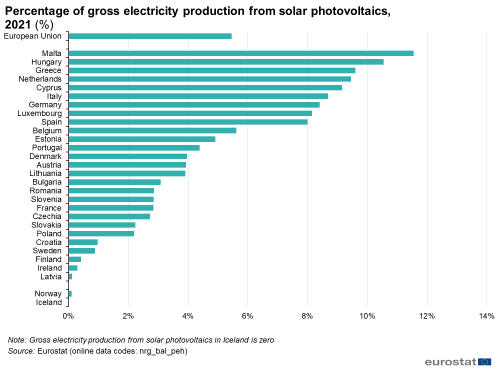
(EUR per kWh)
Source: Eurostat (nrg_bal_peh)
Electricity consumption in road transport
When referring to electricity consumption in road transport, we include the electricity used for charging electric vehicles, as well as the electricity consumed by electric trolley buses. In absolute terms for 2020, first is Norway, where 1 089 GWh are mostly used for charging electric vehicles. Netherlands and Sweden follow with the consumption of 673 GWh and 495 GWh respectively, mostly for electric vehicles charging.
Source data for tables and graphs
Data sources
Energy commodities extracted or captured directly from natural resources are called primary energy sources, while energy commodities which are produced from primary energy sources in transformation plants are called derived products. Primary energy production covers the national production of primary energy sources and takes place when natural resources are exploited, for example, in coal mines, crude oil fields, hydropower plants, or in the fabrication of biofuels. Whenever consumption exceeds primary production, the shortfall needs to be accounted for by imports of primary or derived products.
The heat produced in a reactor as a result of nuclear fission is regarded as primary production of nuclear heat, alternatively referred to as nuclear energy. It is calculated either on the basis of the actual heat produced or on the basis of reported gross electricity generation and the thermal efficiency of the nuclear plant. Primary production of coal and lignite consists of quantities of fuels extracted or produced, calculated after any operation for the removal of inert matter.
Context
In 2016, the European Commission presented the European Strategy for Low-Emission Mobility COM2016(501) final. The Commission identified low-emission mobility as an essential component of the broader shift to the low-carbon, circular economy needed Europe to stay competitive and be able to cater to the people and goods mobility needs.
The Fit for 55 legislative proposals cover a wide range of policy areas including climate, energy, transport and taxation, setting out the ways in which the Commission will reach its updated 2030 target in real terms.
Direct access to
Other articles
Dedicated section
Methodology
- Energy statistics - quantities (nrg_quant) (ESMS metadata file — nrg_quant_esms)
